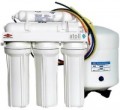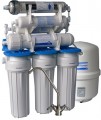Stages of purification
The number of purification stages provided for in the filter design. At each stage, water passes through its own filter element, clearing itself of certain contaminants; in this case, the steps are arranged in order from coarser cleaning to finer. For example,
a three-stage system may look like this: the first stage is mechanical removal of impurities, the second stage is the removal of ferrous, and the third is filtration through a carbon cartridge.
The more stages of purification — the more advanced the filter is considered, the cleaner water it usually provides at the outlet. Accordingly, this moment largely depends on the purpose (see “Type”): for example, multi-stage filtration is quite rare in main models, it is practically not used at all in pre-filters, but the number of stages can reach 9 in models for sink.
Filtration speed
The amount of water that the filter is able to pass through itself per unit of time (of course, effectively purified in the process); usually stated in liters per minute. This parameter is largely related to the type (see above): for example, in jugs, the filtration rate usually does not exceed 0.5 L per minute, while for main devices that supply entire apartments, a throughput of tens or even hundreds of liters is required.
Note that it does not always make sense to pursue a high filtration rate. After all, other things being equal, finer cleaning takes more time; accordingly, the faster the filter works, the higher the chance that the quality of such cleaning will be relatively low. And devices that purify water efficiently and quickly usually have an appropriate price. Therefore, it is worth considering the purpose of the filter and, on the basis of this, determine the balance between the filtration speed and its quality when choosing. It is also worth keeping in mind the conditions of use: for example, if you need to filter low-quality tap water for drinking, it is better to sacrifice speed in favor of efficiency.
Resource
The resource can be described as the total amount of water (in thousands of liters) that the filter is able to clean before the cartridge needs to be changed. Usually, it is indicated for a standard filter element (see "Removable cartridges").
Different types of filters (see above) can significantly differ in resource, depending on the features of their application. However, for all models, the rule applies: do not use a cartridge that has exhausted its resource. This is due not only to a drop in filtration efficiency — an “overfilled” filter can begin to release the accumulated contents into the water, further degrading its quality. Since it can be quite difficult to monitor of a specific amount of treated water, many manufacturers indicate the approximate time in which it will be exhausted with an average intensity of use in addition to the resource. Usually it is a few months, but there are exceptions. In addition, for the convenience of the user, various indicators can be provided in the filter design (see "Cartridge replacement indicator").
In models with a multi-stage design (see "Stages of purification"), where there are several cartridges, their resource usually differs, and the total filter resource is usually indicated by the least durable cartridge, that is, until the first replacement of any of the filter elements.
Fitting size
The diameter of the pipes to which the filter is designed to be connected; indicated only for models with water connection, see "Connection". In plumbing, pipes of standard diameters are usually used, and inches are used for measurement — for example, 0.75", 1", etc. Most filters are equipped with a set of adapters for different pipe diameters, therefore, most likely there will be no connection problems, even if the initial diameters do not match. Nevertheless, it is best to choose a filter that matches your water supply in terms of fitting size — in this case, the connection is more reliable, and compliance with the claimed characteristics will be complete.
Max operating temperature
The highest inlet water temperature at which the filter is able to operate normally. Modern filters are conditionally divided into models for cold and hot water: the operating temperature in the first case does not exceed 40 °C, and in the second it can reach 95 °C. For more information on the importance of matching water temperature and filter characteristics, see "Purpose".
Cartridge size
The cartridge size indicates both the overall dimensions of the device and compatibility with non-native accessories from other manufacturers. Cartridges differ in width and height, measured in inches. Among the most common options are
5SL (5"x2.5"),
10SL (10"x2.5"),
20SL (20"x2.5"),
10BB (10"x4.5"),
20BB (20"x4.5").
Standard sizes also include
inline cartridges in the form of modules made from white or transparent plastic. They are a sealed cylinder with pre-installed inlet and outlet fittings. Inline cartridges are connected via threaded connections or fittings, simplifying the replacement process. They do not require a separate housing for installation, as their design allows for direct connection to the pipeline or filtration system. They are also slimmer than traditional filters, making a filter with inline cartridges quite presentable in appearance.
Some water purification systems have cartridges in
proprietary sizes that are only compatible with specific filters. These cartridges are ideal for these systems, providing high purification efficiency. They often combine several filtration stages in one element (e.g., mechanical cleaning, chlorine removal, mineralization). This simplifies system maintenance and improve
...s water quality. Proprietary products undergo strict quality control and are tested for compatibility with specific filtering systems, ensuring stable performance. However, there are drawbacks—proprietary cartridges are more expensive and their range is much smaller than universal ones.Replacement cartridges
Models of replaceable cartridges for which the filter is designed. Knowing the names of models, it will be much easier for you to find a replacement for an exhausted cartridge. In addition, the options directly named by the manufacturer are fully compatible with the filter and correspond to official specifications, while there is no such guarantee for "non-native" cartridges.
Several names in this paragraph are usually indicated for filters with multi-stage filtration (see "Stages of purification") — a cartridge for each stage.

